-
PDF
- Split View
-
Views
-
Cite
Cite
Thiago De Carvalho Moretti, Wesley Augusto Conde Godoy, Spatio-Temporal Dynamics and Preference for Type of Bait in Necrophagous Insects, Particularly Native and Introduced Blow Flies (Diptera: Calliphoridae), Journal of Medical Entomology, Volume 50, Issue 2, 1 March 2013, Pages 415–424, https://doi.org/10.1603/ME12187
Close - Share Icon Share
Abstract
We carried out a year-long survey of insects, using carrion-baited traps in the municipality of Campinas and five surrounding municipalities with different urbanization profiles, in southeastern Brazil. We studied the spatio-temporal variability and preferences for type of bait of three blow fly species that are forensically important in Brazil: Chrysomya albiceps (Wiedemann), Chrysomya megacephala (F.), and Lucilia eximia (Wiedemann). All three species preferred chicken. C. albiceps and L. eximia preferred the urban environment, while C. megacephala preferred the rural environment. Calliphoridae, Muscidae, Fanniidae, and Sarcophagidae were the most numerous families. No clear seasonal patterns could be recognized for the three species. The associations of species/municipality, species/environment, and species/bait are discussed from the ecological and forensic standpoints.
Brazil had a homicide rate of 26.2/100,000 inhabitants in 2010 (Vasconcelos and Araujo 2012). Although homicide rates in the capital of the state of São Paulo have decreased slightly in the last 10 yr, other cities in the state have experienced rising rates of this type of crime in the same period (Waiselfisz 2011). Prompt utilization of novel tools is needed to help to solve these crimes, and medico-legal entomology is one such tool. The main goal of this branch of forensic science is to assist police forces with estimating the minimum postmortem interval (PMImin), by using arthropods associated with human remains (Boatright and Tomberlin 2010, Michaud et al. 2012).
The environmental and biogeographical conditions to which a corpse is exposed greatly affect the species composition, relative abundance, and dynamics of carrion-frequenting arthropods (Shean et al. 1993). Therefore, it is critical to conduct surveys of these species at each specific site where forensic-entomology tools are to be used, because data from a given locale cannot be applied directly to any other area, even for relatively close sites in neighboring states and provinces (Aballay et al. 2012).
This problem is particularly acute in a country such as Brazil, with an enormous territory and wide variations in temperature, altitude, rainfall patterns, and population densities. Regional or local surveys of arthropod species and the development of faunal checklists are of fundamental importance, because they establish baseline data for the implementation of forensic entomology in a particular locality, and also help to understand the biodiversity and distribution patterns of species (Ulysséa et al. 2011). Discrepancies between the insects found at a corpse and the composition of insect species at the site of discovery may indicate that the victim was transferred from its original location (Amendt et al. 2011). Knowing the faunistic composition of each of the subzones of an area may be crucial to draw such conclusions in Brazil.
The necrophagous insects are mainly represented by certain families of flies (Diptera) and beetles (Coleoptera) (Souza and Linhares 1997, Michaud et al. 2012). Among the necrophagous flies, the blow flies (Calliphoridae) are usually the first insects to arrive at carcasses/corpses, and are therefore valuable in providing data to accurately estimate the period of insect activity (PIA), which can correspond to the minimum estimate of the postmortem interval (Byrd and Castner 2010). Blow flies have also been receiving attention from ecologists because their biological attributes are easily analyzable in experimental studies, through the connection between field and/or laboratory experiments and ecological modeling (Godoy 2007).
Three of the most forensically important blow flies in Brazil are Chrysomya albiceps (Wiedemann), Chrysomya megacephala (F.), and Lucilia eximia (Wiedemann) (Souza and Linhares 1997). C. albiceps and C. megacephala originated in the Old World tropics and were introduced into Brazil in 1975 and 1976, with the large influx of Angolan refugees on ships (Guimarães et al. 1978). L. eximia is a Nearctic and Neotropical species that is common in rural and urban areas, and breeds primarily in carcasses but also in rotten fruit and urban garbage (Madeira et al. 1989). These calliphorids are dominant in various surveys of the entomofauna of carrion and corpses in Brazil (Monteiro–Filho and Penereiro 1987, Souza and Linhares 1997, Carvalho et al. 2000, Moretti et al. 2008). The three species are of major medical and veterinary importance because they are vectors of viruses, bacteria, and helminthes, are causative agents of myiasis, and are of potential use in maggot debridement therapy (MDT) (Godoy 2007). The definitive establishment of species of Chrysomya in Brazil affected the dynamic behavior of native blow flies, which is an important factor in the evaluation of demographic aspects of biological invasions (Godoy 2007). In addition, studying the population dynamics of these blow flies will likely be a key step in understanding possible changes in the dynamics of the diseases for which they serve as vectors.
Blow fly species/habitat associations vary both locally and geographically (Hwang and Turner 2005). Hwang and Turner noted that occasional irregularities occur in such species-habitat association patterns, because some species may occur over a very broad range of habitats.
The spatial distribution of a species is the result of complex ecological interactions between the organisms and their environments, as well as of the differentiation among niches (Price 1997). The spatial structure has important implications for competitive coexistence (Nee and May 1992) and for the regional persistence of small populations that might be subject to local extinction (Day and Possingham 1995). In addition to the spatial variations, temporal changes in activity result from the interactions among intrinsic rhythms and seasonal effects (Hwang and Turner 2005). Several investigators (Hastings 1990, Tilman and Kareiva 1996, Kot 2001) have carried out quantitative studies on the resulting effects on the spatio-temporal distribution of species in their habitats.
In Brazil, several research groups have been targeting the formation of a genuinely national forensic-entomology database, with the aim of creating a solid biological and ecological foundation to aid in the definitive implementation of the area in the country (e.g., Souza and Linhares 1997, Carvalho et al. 2000, Moretti et al. 2008, Biavati et al. 2010, Oliveira and Vasconcelos 2010). The complexity inherent in this field makes it necessary to carry out more extensive and intensive investigations. It is needful to develop tools (including mathematical models) appropriate for use in Brazil, to replace those presently in use, which are based on research in temperate countries. The spatial distribution of forensically important insect species within Brazil is an aspect that merits particular attention.
Some forensic-entomology studies have been conducted in and around the municipality of Campinas. These have simply surveyed the cadaver-associated arthropods and studied local succession patterns, or have compared the necrophagous-insect fauna between sunlit and shaded areas, between carcasses of different sizes, or among carcasses exposed in different seasons (e.g., Monteiro–Filho and Penereiro 1987, Souza and Linhares 1997, Moretti et al. 2008). However, none of these studies compared the composition of necrophagous insects in different types of environments within Campinas or between Campinas and its neighboring cities. The municipalities that we studied have very diverse urbanization profiles, and we believe that studies exploiting this heterogeneity could provide important insights to improve understanding of ecological and forensic aspects of carrion-related flies. In addition, unlike most studies conducted to study carrion-fly assemblages, which explored urban-rural gradients (e.g., Hwang and Turner 2005), we have sampled over a broader gradient, including the forest habitat.
The main aims of the current study were: 1) to carry out a survey, over 14 mo, of insects attracted to carrion-baited traps in six municipalities with different urbanization profiles in São Paulo State, southeastern Brazil; 2) to assess the preference of these insects for a particular environment (rural, urban, or forest) and for the type of bait (fish, beef liver, or chicken gizzards); 3) to analyze the spatio-temporal variability and preferences for type of bait of three species of blow flies of major forensic importance in Brazil, C. albiceps, C. megacephala, and L. eximia; and 4) to study the correlation between the abundances of these three species and weather variables (temperature and rainfall). The associations of species/municipality, species/environment, and species/bait will be discussed from the ecological and forensic standpoints.
Materials and Methods
Some parts of the methods described here are similar to those used by Moretti et al. (2011b), but are repeated here for the sake of clarity.
Study Sites.
The collections were carried out in rural, urban, and forest environments in six municipalities in São Paulo State, southeastern Brazil (Fig. 1): Artur Nogueira (22° 34′22″ S, 47° 10′22″ W), Campinas (22° 53′20″ S, 47° 04′40″ W), Cosmópolis (22° 38′45″ S, 47° 11′46″ W), Jundiaí (23° 11′11″ S, 46° 53′03″ W), Mogi Guaçu (22° 22′20″ S, 46° 56′32″ W), and Paulínia (22° 45′40″ S, 47° 09′15″ W).
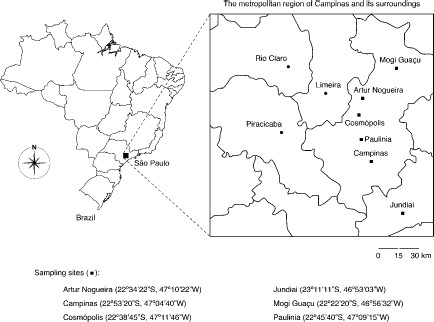
The rural areas in these municipalities are homogeneous, with moderate agricultural activity and livestock farming, and a few scattered houses. Most of the urban sites have modest commercial activity, except Campinas (1,080,113 inhabitants and an area of 795 km2) and Jundiaí (370,126 inhabitants and an area of 431 km2) (Instituto Brasileiro de Geografia e Estatística [IBGE] 2012), the two largest cities monitored, which have very high levels of urbanization, dense housing and intense commerce. Finally, the forest sites are mainly remnant woodland patches with similar phytophysiognomic features, except Campinas, where the forest area is a 250-ha mesophilic semideciduous Atlantic Forest fragment (Morellato and Leitão Filho 1995) surrounded by human dwellings (Moretti et al. 2011b).
All the cities have similar climate according to the Köppen classification: Cwa - subtropical climate, with cool dry winters (temperatures below 18°C) and warm humid summers (with the mean temperature in the warmest month above 22°C), as generally occurs in central and eastern regions of the state of São Paulo at altitudes between 500 and 700 m (Setzer 1966).
Field and Laboratory Procedures.
Monthly collections were made from September 2006 through October 2007. Each of the environments in each municipality was monitored using six traps per month, two for each kind of bait, totaling 18 traps per municipality/month and 1,512 sample units during the entire study (18 traps × 6 cities × 14 mo of collection). Baits composed of 12 g of one of the following: fish (sardines), beef liver, or chicken gizzards were used, after being allowed to rot for ≈48 h at room temperature. Carrion traps were installed ≈15 m apart at the collection sites. Each trap (Fig. 2) was made of two 2.0-liter plastic soft-drink bottles, each ≈30 cm in height and 10 cm in diameter. The bottoms of both bottles were removed to allow one to fit into the other and to allow insects to enter through the bottom opening of the lower bottle, which was painted black. The cap of the lower bottle was also removed, so its top end was open. Each bait was placed at the top end of the lower bottle with a small metal hook, and was replaced in the traps every 24 h.
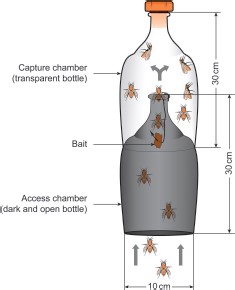
Carrion trap used to collect necrophagous insects in southeastern Brazil (adapted from Moretti et al. 2011b). (Online figure in color.)
Each trap was suspended by a cord from a tree branch, ≈180 cm above the ground. The trap remained exposed at the study site for a period of 72 h, after which all insects trapped in the upper bottle were collected, taken to the laboratory, and killed by freezing at −20°C, until later identification. After identification, the specimens were stored in the same freezer where they were killed.
Part of the collected material was pinned and deposited in the ESALQ Entomological Museum, Department of Entomology and Acarology, ESALQ/USP, Piracicaba, São Paulo, Brazil. The remaining specimens were preserved in 70% ethanol.
Identification of Specimens.
Insects in general were identified using the keys by Triplehorn and Johnson (2005). Diptera were identified using references by McAlpine (1981) and Carvalho and Mello–Patiu (2008). André Victor Lucci Freitas (University of Campinas) identified the species of Lepidoptera.
Meteorological Measurements.
Temperature (°C) and rainfall (mm) were obtained for each municipality and collection month from CIIAGRO (Centro Integrado de Informações Agrometeorológicas).
Statistical Analyses.
Analysis of Variance (ANOVA). A one-way ANOVA (Gotelli and Ellison 2004) (independent variables: municipality, environment, and bait; dependent variable: abundance) was used to compare the mean abundances for the three calliphorid species C. albiceps, C. megacephala, and L. eximia among the six municipalities, after verification of normality (P < 0.01) (Beiguelman 2002).
χ2 Test. To evaluate the possible preferences of C. albiceps, C. megacephala, and L. eximia for type of environment (rural, urban, or forest) and bait (fish, beef liver, or chicken gizzards), we used the χ2 test (Beiguelman 2002) based on the frequencies of areas or baits that were preferred or not preferred by the three species.
Pearson's Coefficient of Correlation (r).Pearson's Coefficient of Correlation was calculated to evaluate the correlation between the abundance of specimens of C. albiceps, C. megacephala, and L. eximia collected and the environmental variables (mean temperature and rainfall).
Results
General Faunistic Survey.
We collected a total of 21,005 specimens of insects. Most of these were collected in the rural areas (n = 8,936), followed by the forest (n = 6,094) and urban environments (n = 5,975). Regarding bait preference, most insects were attracted to chicken gizzards (n = 12,267), followed by fish (n = 7,167) and beef liver (n = 1,571) in that order. Table 1 shows the abundance and occurrence by type of bait and environment of insects (n = 8,265) caught in the six municipalities during the collection period. We have not included in this table the families Calliphoridae (n = 12,627), which will be treated in detail throughout this article, and Formicidae (n = 113), for which the analysis will be published elsewhere. The abundances of the 10 most numerous families are shown in Fig. 3 (n = 20,960). Regarding Diptera, we collected specimens from the following families: Calliphoridae, Muscidae, Fanniidae, Sarcophagidae, Anthomyiidae, Drosophilidae, Micropezidae, Neriidae, Phoridae, Piophilidae, and Ulidiidae. A few specimens of so-called genuinely phytophagous insects, such as Acrididae, Apidae, Gryllidae (Nemobiinae), and Tettigoniidae (Copiphorinae) were also collected.
Abundance and occurrence by type of bait and environment of insects caught in the six municipalities during the collection period (n = 8,265; not including ants and blow flies)
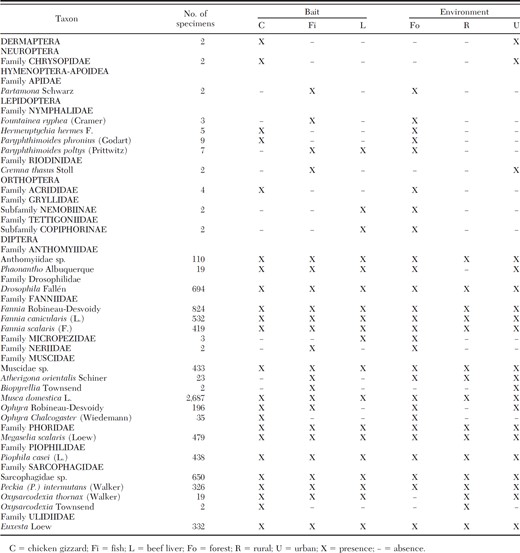
Abundance and occurrence by type of bait and environment of insects caught in the six municipalities during the collection period (n = 8,265; not including ants and blow flies)

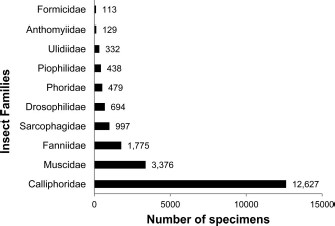
Abundance of the 10 most numerous families collected (n = 20,960).
The abundances of the nine species of blow flies collected: C. albiceps, C. megacephala, Chrysomya putoria (Wiedemann), Cochliomyia macellaria (F.), Hemilucilia semidiaphana (Rondani), Hemilucilia segmentaria (F.), Lucilia cuprina (Wiedemann), L. eximia, and Mesembrinella bellardiana (Séguy) are shown in Fig. 4.
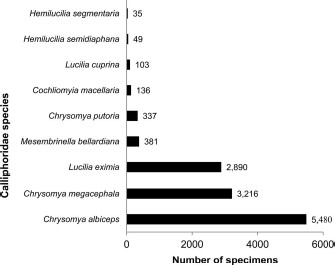
Spatio-Temporal Variability and Preferences for Type of Bait for C. albiceps, C. megacephala, and L. eximia.
The distributions of C. albiceps, C. megacephala, and L. eximia according to type of bait and environment are shown in Table 2. The χ2 test showed that for C. albiceps, the difference among the percentages of preference for area was statistically significant, that is, this species preferred urban environments, followed by rural (χ2 = 905.9; df = 2; P < 0.01). Regarding the type of bait, C. albiceps preferred chicken, followed by fish (χ2 = 4135.9; df = 2; P < 0.01).
Distribution of C. albiceps, C. megacephala, and L. eximia according to type of bait and environment
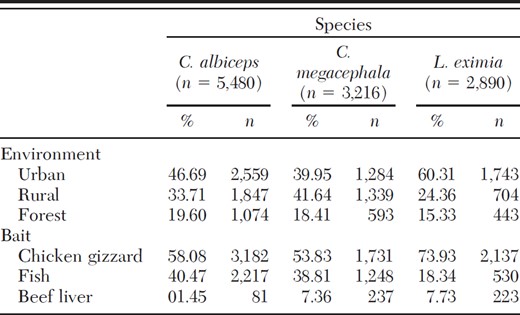
Distribution of C. albiceps, C. megacephala, and L. eximia according to type of bait and environment

For C. megacephala, the preference was for the rural area, followed by the urban one (χ2 = 483.6; df = 2; P < 0.01). However, the difference between the rural and urban areas was not significant (χ2 = 1.87; df = 1; P = 0.17). Regarding the type of bait, C. megacephala preferred chicken, followed by fish (χ2 = 1626.6; df = 2; P < 0.01).
Finally, L. eximia preferred the urban, followed by the rural environment (χ2 = 1472.8; df = 2; P < 0.01). Regarding the type of bait, L. eximia preferred chicken, followed by fish (χ2 = 3290.7; df = 2; P < 0.01).
The abundances per municipality and month of collection for C. albiceps, C. megacephala, and L. eximia are shown in Tables 3, 4, and 5, respectively. Campinas and the September–November period (in both 2006 and 2007) were the municipality and months with the highest abundances for C. albiceps. For C. megacephala, the highest abundances occurred in Cosmópolis and in November 2006; and for L. eximia, Artur Nogueira and April 2007. For C. megacephala (F = 1.383; P = 0.239) and L. eximia (F = 0.735; P = 0.599), the abundances did not differ significantly among the municipalities; however, the difference in the abundance of C. albiceps (F = 3.969; P = 0.002) was significant.
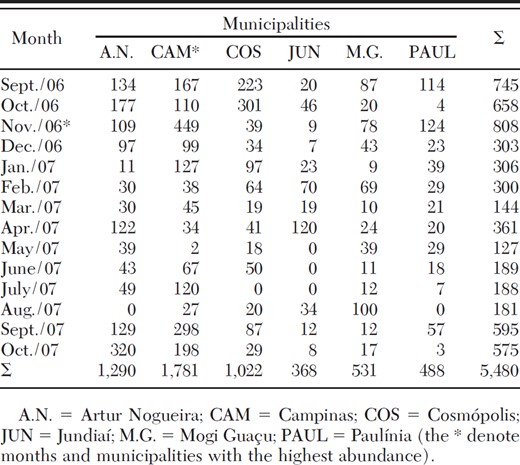

Number of specimens of C. megacephala per municipality and month of collection
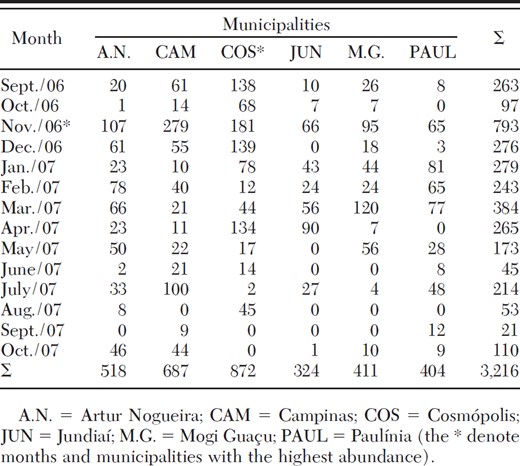
Number of specimens of C. megacephala per municipality and month of collection



Pearson's Coefficient of Correlation (r).
The correlations were weak, although significant (P < 0.05) (Table 6). The abundance of C. albiceps was least correlated with the environmental variables (mean temperature and rainfall), and the abundance of C. megacephala was most highly correlated with these variables. Monthly records of temperature (°C) and rainfall (millimeters) for the six municipalities from September 2006 through October 2007 are shown in Table 7.
Correlation between C. albiceps, C. megacephala, and L. eximia, and weather variables (temp and rainfall)
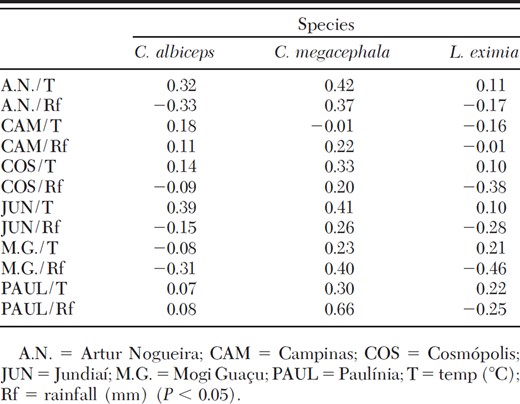
Correlation between C. albiceps, C. megacephala, and L. eximia, and weather variables (temp and rainfall)

Temperature (°C) and rainfall (mm) in the six municipalities during the collection period

Temperature (°C) and rainfall (mm) in the six municipalities during the collection period

Discussion
Regardless of the reasonably large number of taxa attracted to decaying animal matter in the current study, very few species dominated in terms of abundance. This pattern agrees with the findings of Hanski (1987), who stated that carrion-associated dipteran assemblages are generally dominated by one or a few species.
Calliphoridae, Muscidae, Fanniidae, and Sarcophagidae were the most numerous families in the current study, as also found in various surveys carried out in different regions of Brazil (e.g., Souza and Linhares 1997, Carvalho et al. 2000, Carvalho and Linhares 2001, Carvalho et al. 2004, Moretti et al. 2008, Oliveira and Vasconcelos 2010).
The blow flies M. bellardiana, H. semidiaphana, and H. segmentaria, as also reported by Carvalho et al. (2000) and Biavati et al. (2010), were collected exclusively in the forest areas, suggesting that these species can be used as forensic indicators for this type of environment. However, the precise determination of forensic indicators should preferably involve the breeding of the insect on carrion (Souza and Linhares 1997). The same occurred with the family Nymphalidae. According to Baz et al. (2010), the feeding behavior of adult lepidopterans is still a neglected subject in the study of the natural history of butterflies. According to these authors, tropical butterflies may complement their nectar-based diet by feeding on a wide range of substrates, including vertebrate carcasses and their fluids. The search for minerals, water or proteins may explain the attraction of Lepidoptera to carrion. According to Payne and King (1969), some butterflies and moths feed exclusively on carrion. Information on the presence of insects from groups that are usually neglected as cadaveric fauna (e.g., Lepidoptera), together with knowledge of their biology and ecology, may provide important tools to increase the accuracy of the estimation of the postmortem interval, when it is based on the succession patterns (changing in the faunistic composition) (Byrd and Castner 2010).
The role of the calliphorid C. albiceps in regulating the densities of other species has been highlighted in studies of population dynamics, faunistic succession, and other ecological aspects important to the medicolegal area (Grassberger et al. 2003, Serbino and Godoy 2007). C. albiceps is an intraguild predator in the larval phase (Faria et al. 1999), and may predate upon eggs and larvae of other insects, particularly muscoid dipterans that visit a cadaver, thus affecting the faunal composition. The stronger competitive attributes of C. albiceps, which allow it to overcome adverse environmental conditions, may explain why the abundance of this species is least closely correlated with the environmental variables.
The abundance of C. albiceps differed significantly among the municipalities studied. The fact that this species is predaceous in the larval phase may explain this variation. The conditions that govern the rates of predation are environmental, demographic, and interactive in nature, and certainly affect the insect populations of the different municipalities in different ways. Our finding that C. albiceps was the most abundant blow fly species agrees with that of Souza and Linhares (1997), who worked in the outskirts of the municipality of Campinas with domestic-pig carcasses as their carrion source. Monteiro–Filho and Penereiro (1987) and Mendes and Linhares (1993), also in Campinas, used small baits (rodents and poultry viscera), but they collected this species in comparatively low numbers. Therefore, the influence of size and type of bait in attracting C. albiceps needs further investigation.
The abundance of each species of blow fly varied among the municipalities because of both environmental factors and predation by C. albiceps. The factors that govern these variations in abundance are important for the forensic sciences, because they can elucidate the circumstances under which the fauna may be more or less restricted.
The second most abundant blow fly was C. megacephala, as also found by Souza and Linhares (1997). In contrast, we collected few specimens of C. putoria, possibly because this species prefers other media than carrion for oviposition (Avancini and Linhares 1988). L. eximia, the third most abundant blow fly, seems to be especially adapted for colonizing small carcasses (Moretti el al. 2008). C. macellaria, another native species, was much less abundant, because it is competitively weaker than the introduced species of Chrysomya (Serra et al. 2007).
Most of the specimens of C. albiceps, C. megacephala, and L. eximia were collected using chicken gizzards as bait. A possible explanation is that this bait emitted a much stronger putrid odor, which could have attracted more flies than the other two types of bait. Although they showed statistically significant preferences for urban or rural environments, these three species are generally synanthropic, as also found by Souza and Von Zuben (2012) in a municipality ≈85 km distant from Campinas.
Among the 10 most abundant families collected, Ulidiidae is perhaps the least studied in forensic-entomology investigations. Ulidiidae is primarily a saprophagous family; the larvae and adults feed on a variety of crops, especially feed corn and sweet corn. Some species may breed in dung and other excrement (Link et al. 1984). However, reports of members of Ulidiidae in vertebrate carrion are very few (but see, e.g., Moretti et al. 2008). The general biology of this family is still inadequately known. The presence of Ulidiidae at carcasses could indicate an oviposition attempt, because the exudates from the decomposing baits could serve as a substrate for the development of the larvae, which are normally found in decomposing plant matter. Further studies on the possible forensic use of genera of Ulidiidae are desirable.
Faunistic surveys carried out in a particular time period and space enable ecological investigations at the population and community levels, using data on diversity and abundance (Godoy 2007). The information obtained enables us to project ecological trends for successive generations under the specific conditions studied (Turchin 2003).
We are aware that the carcass of the domestic pig, Sus scrofa (L.), is the best research model for forensic entomology (Tomberlin et al. 2012). However, the large number of sample units in our experimental design made the use of pig carcasses impractical (Moretti et al. 2011b). Hwang and Turner (2005) analyzed the possible biases inherent in the sampling method used here, and concluded that this method is adequate for making relative comparisons between sites. In addition, this sampling method allows traps to be distributed in a wider range of sites/municipalities. We also note that replacing the baits in the traps every 24 h may have influenced the outcome, because fresh and old baits attract different types of insects, especially different cohorts of flies (George et al. 2012).
Although the municipalities that we studied have the same climate, they differ in aspects such as the number of inhabitants, population density, production of decomposing organic matter, and urbanization profiles. These differences may account for the diverse composition of the carrion entomofauna among the cities. It is of particular interest to study the composition of necrophagous insects in the forest and rural areas of the municipalities where we performed our investigation, because these two types of environments are commonly used by criminals to dispose of cadavers.
With respect to the individual populations of most calliphorid species that we studied, Campinas showed the highest abundance of specimens, while the abundances of calliphorids in the other, nearby municipalities were similar. This was expected because Campinas is much larger than the other cities, and thus produces much more decomposing organic matter, which provides a wider variety of ecological niches and larger amounts of media for breeding of flies, such as human excrement or garbage of vegetable and animal origin, animal carrion, slaughterhouse refuse (e.g., bones and meat), and animal dung (Norris 1965).
These observations agree with the ecological pattern conventionally described for population models (Hanski 1999), in which a productive source of resources supports the subpopulations coupled by migration, either by recolonizing sites where a population has become extinct or by preventing local extinctions. Several factors are essential for understanding the mechanisms responsible for the dynamic behavior of natural populations. The complexity introduced by migration among local populations is one such factor (Hanski and Gilpin 1997, Hanski 1999, Serra et al. 2007).
The connection among local populations can elucidate possible relationships among the level of dispersal, the dependence on density, and the stabilizing role of dispersal in potentially chaotic models, with repercussions for the probability of local and global extinctions (Hastings 1993, Bascompte and Solé 1994, Hanski and Gilpin 1997). Mutually distant municipalities will certainly have lower migration rates than municipalities that are closer to each other, and this may define faunistic patterns, which are fundamental for the faunistic mapping of species of forensic interest for a given area.
Although some peaks in temporal abundance could be observed, clear seasonal patterns could not be recognized for C. albiceps, C. megacephala, and L. eximia. Their temporal variations seemed to be randomly determined. Seasonal patterns are forensically important because they may designate species to be used as indicators of seasons (Hwang and Turner 2005) or may define the season of death for corpses with a long PMI (Moretti et al. 2011a). If we had used longer sampling periods, seasonal patterns might have appeared. Lack of a seasonal pattern for carrion flies was also observed during insect colonization of rodent carcasses in a secondary forest in the outskirts of Campinas (Moretti et al. 2008). Nonetheless, it should be stressed that seasons in tropical regions tend to be less well defined than in temperate or in Mediterranean zones.
In the current study, we intended to deal with basic aspects of the ecology of sarcosaprophagous flies in urban, rural, and forest areas of southeastern Brazil, aiming to encourage specialists to address their attention to the gaps that have not been systematically observed through the implementation of forensic entomology in Brazil. These kinds of studies are important to place the field of forensic entomology on firmer footing in this country.
Acknowledgments
T.C.M. has been supported by a scholarship from FAPESP (São Paulo Research Foundation), grant 06/60504-9, and W.A.C.G. has been partially supported by a grant from CNPq (The National Council for Scientific and Technological Development). The observations reported in this study are part of a Thematic Project named “Forensic Entomology: The Utilization of Arthropods for Determining Time, Place, Cause, and Circumstances of Death,” supported by FAPESP, grant 04/08544-0. We thank André Victor Lucci Freitas for kindly identifying the species of Lepidoptera, and Vinícius Bonato for patiently providing us with advice on statistics.
References Cited



